Content [show]
Lemon - a tree of the genus Citrus, everyone knows its fruit. The homeland of this plant is China, India and the Pacific tropical islands.
Lemon was first introduced by the Arabs to the Middle East, North Africa, Spain and Italy.
Is it possible to grow a lemon from a seed at home?
People know about the benefits of lemon firsthand. Lemon is an excellent remedy for many ailments... It strengthens the immune system, normalizes hormones, improves vision, and stimulates the digestive tract.
It is used for colds, as it contains a huge amount of vitamin C and many people just like the sour, aromatic taste.
It is possible to grow lemon at home. If you cut a lemon, you can see a lot of seeds. It is quite possible to grow a full-fledged lemon tree from these seeds.
To a man who decided to plant a lemon at home, it is important to consider the following rules:
- the fruit should be yellow, the most ripe, since if the lemon is green, then due to the fact that it is not ripe, the germs of sprouts in the seeds of such a lemon may not sprout;
- for planting, it is important to choose several large seeds - from 10 to 15 pieces, so that later you can choose a beautiful and actively growing seedling;
- it is important to choose a suitable variety that will grow well at home.
 For cultivation, you must choose the right variety of lemon, the fruit must be ripe, the seeds are large
For cultivation, you must choose the right variety of lemon, the fruit must be ripe, the seeds are large
Suitable variety for a house or apartment: Pavlovsky, Meyer and others
There are many varieties. Below are some of them that are suitable for growing in a house or apartment:
- Pavlovsky - differs from other varieties in its large fruits, which can reach 500 grams, has a sweetish taste, and the tree of this variety is quite large - more than 2 meters. This variety is distinguished by fragrant leaves. The scent is so sharp and strong that the whole house will be filled with it.
- Meyer - a hybrid of lemon with grapefruit, has a sweet and sour taste, a small tree with a rich harvest, the size of one lemon can reach 150 grams, blooms in bunches, there is a seasonal dormant period.
- Ponderosa - a hybrid of lemon with grapefruit, has a bitter taste, as well as the presence of a large number of seeds. Pleases that it constantly blooms. According to the people who grow this type of lemon, it is a very grateful plant and quite unpretentious.
- Genoa - an average tree, gives a large yield already for 4-5 years of life. Fruits with delicate pulp, have a sour, aromatic taste. You can also eat the rind. This variety is considered not whimsical. For 2-3 years, the seedling is already blooming.
- Anniversary - a medium-sized tree, considered a variety that gives a rich harvest, the fruit is distinguished by its thick skin. Very suitable for growing in a house or apartment.
After the stage of selecting the variety has been passed, it is necessary to proceed to the very planting of the seeds in the pot.
 Varieties that are suitable for growing in a house or apartment: Pavlovsky, Meyer, Genoa, Yubileiny, Ponderoza
Varieties that are suitable for growing in a house or apartment: Pavlovsky, Meyer, Genoa, Yubileiny, Ponderoza
How to plant plant seeds: highlights
Some active citrus growers with a wealth of experience it is advised to free the bone from the upper husk, which in their opinion allows you to get seedlings in the shortest possible time.
This must be done very carefully, since any damage to the seed can lead to the fact that the germination of the seed does not occur.
But you can plant bones without the above procedure.
Lemon seeds must be wet before planting... It is advisable to soak them for a day in water or in a solution of sodium humate. You can buy this growth stimulant at any botanical store.
But even if the seeds were planted without soaking, and as soon as they were removed from the lemon, they will most likely sprout.
Next, you need to find a suitable small, shallow pot or glass, pour earth into it. There should be holes in the bottom of the pots... They are important so that excess moisture, due to which the roots of the sprouts may die, flows down.
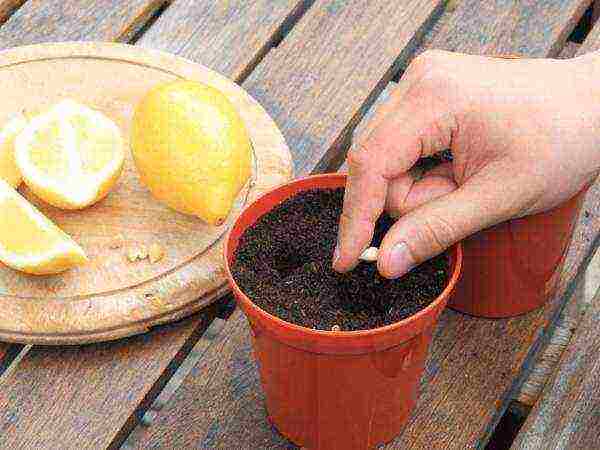 Make holes in the bottom of the pot, fill with small pebbles, soil
Make holes in the bottom of the pot, fill with small pebbles, soil
Put 1.5-2 cm of expanded clay, small pebbles or very coarse sand on the bottom of the pot. Planting soil can be purchased at the store, but you can prepare yourself. To do this, you need to mix garden soil, sand, humus and a little charcoal.
It is better to plant bones to a depth of no more than 1.5-2 cm... It is important to moisten the soil before planting. It should not be dry, but excessive moisture is also undesirable.
The pot can be covered with plastic wrap. The air temperature in the room where the seed pot is located should be above + 18 ℃.
Spray the soil once every 2-3 days... If the ground has become completely dry, then you can water it a little. After the first shoots appear, the film must be removed.
It is better to rearrange the pot with sprouts in a bright place and water with settled or rain water, at room temperature.
The first shoots will sprout no earlier than 3-4 weeks after planting.
According to experienced citrus growers, the best time to plant lemon is late winter, early spring... Since the increasing daylight hours will only benefit the young sprouts that have appeared.
Will the indoor lemon tree bear fruit?
Many people think that growing a lemon from a seed is a thankless job. Since it will take 5, 7, or even all 15 years to wait for fruits from such a lemon, and its fruits will be small in size.
For, in order not to wait for decades when the lemon tree begins to bear fruit, it must be grafted... This can be done in two ways during the warm season (summer or warm spring):
- Into the cleft - the preferred type of grafting. It is necessary to take a stalk of a cultivated fruiting lemon. A branch is cut on the seedling, and the remaining stem of the seedling is split. A "wedge" is sharpened on the cutting of a fruiting lemon, which is then introduced into the split in the stem. Next, you need to tie the vaccine with electrical tape. 2-4 buds are left on the cutting of a fruiting lemon, everything else is cut off. The inoculation is covered with a plastic bag. When the vaccine has healed, the bag can be removed.
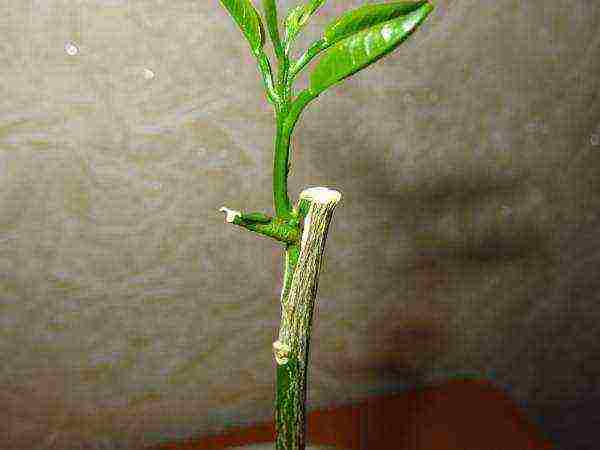 Lemon grafting - by budding or splitting - is necessary for early fruiting
Lemon grafting - by budding or splitting - is necessary for early fruiting
- Oculated - the shoots are cut off from the seedling, a "stump" 10 cm high remains from the tree. Next, they take a sprig of cultivated fruit-bearing lemon. Under each leaf of the twig is the so-called "dormant bud". A slice must be made in front of this kidney. Next, cut off the leaf plate, but leave its petiole.Cut the bark on the "stump" of the seedling and insert the petiole with the cut down. Tie the vaccination site with electrical tape. The stalk of the cut leaf plate will serve as an indicator. If the petiole falls off after 2-3 days, then we can assume that the vaccination was successful, but if it dries up, then the vaccination has failed and must be repeated.
I wonder what grown lemon from seed adapts to home conditions faster and better, it is less picky than grafted and grafted seedlings.
Why lemon grown from seed does not bear fruit:
Optimal growing conditions, care after planting
It is advisable to be very attentive to a lemon that has risen in a pot. When on lemon seedlings 3-4 leaves will appear, they are transplanted into separate pots.
It is recommended to replant young lemon trees up to 2 times a year. It is advisable to do this very carefully so as not to damage the root system.
Typically, lemon can react to both extreme heat and sunlight, as well as cold and strong winds. Therefore, when changing the location of the lemon pot, it is advisable to keep this in mind.
And the best solution would be not to change the place of "residence" of the lemon. The best place for a lemon would be the south or southwest side of the apartment. In terms of temperature, lemon can tolerate temperatures from + 14 ℃ to + 27 ℃.
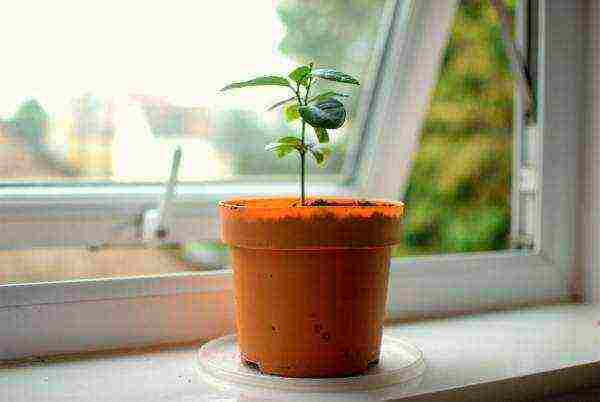 The best place for a lemon would be the south or southwest side of the apartment.
The best place for a lemon would be the south or southwest side of the apartment.
Lemon create conditions without sudden temperature jumpssince they can kill him. It is desirable to maintain a moderate air humidity of 60-70%.
Water the plant best with rainwater at room temperature. In hot summer, it is better to do this 2 times a day. And on cloudy and cold days, it is important to add lighting to lemon with LED or fluorescent lamps.
Feed in summer a seedling can be a solution of humus and liquid mineral fertilizers.
Lemons, like all houseplants susceptible to disease and pest attacks... Therefore, they need careful care, and it is also recommended to carefully examine the plant every day in order to detect the appearance of this or that pest as early as possible and take the necessary measures in time.
Courting and Protecting: The Main Enemies of Citrus
Lemon gets sick if you do not follow the rules of care. If the tree is watered a little, it will dry out. If the soil in the pot is oversaturated with moisture, then yellow leaves will appear on the lemon, and this will be a sign that the roots of the tree are beginning to rot.
Also the appearance of yellow spots on the foliage, after which the leaves dry and fall off, indicate that the wood lacks iron.
Dry leaf ends say that the tree needs phosphorus. A lack of potassium and manganese leads to wrinkling of the leaves and falling off of the ovary.
Knowing how to grow a tree is not enough; it is important to be able to care for it. If a pest is noticed on the plant, it is necessary to figure out what kind of parasite it is and urgently take measures to combat it.
Below are some common parasites that can attack a home-grown lemon:
- Mealybugs, popularly known as "hairy lice" - on a tree they can be recognized by a white bloom. They prefer dry conditions, they are afraid of moisture. A good prevention of this parasite is to regularly rinse all the lemon leaves.
- Shield - small shiny droplets appear on the leaves, sticky to the touch. Leaves dry and fall off. Soapy or garlic water is used against this pest. Soapy water is prepared as follows: 2 tablespoons of liquid soap are dissolved in 1 liter of water. The resulting mixture is treated with the affected tree. An hour after the procedure, they are washed under the shower. It is desirable to repeat the treatment after 2 days.
- Spider mite - small, light dots on the sheet plate. The leaves are curling up. A cobweb is visualized on their back.If this parasite is found on the lemon, it is necessary to treat the tree with sulfur. For prevention purposes, the lemon is washed under running water, paying more attention to the underside of the leaf plates of the tree. Spraying with a solution of water and laundry soap helps to fight the mite well.
 Common parasites that can attack home-grown lemon: mealybugs, scale insects, spider mites
Common parasites that can attack home-grown lemon: mealybugs, scale insects, spider mites
Prevention measures
There are several simple preventive measures that will prevent the attack of parasites or damage to the tree by diseases:
- give a lemon tree a hot shower... The plant will not suffer from this, and unnoticed parasites will be neutralized and washed away;
- spray the leaves (especially from the bottom side);
- wipe the lemon leaves once a week with soapy water (it is better to use laundry soap).
"Fitosporin" is considered a good remedy for many diseases and pests. It is non-toxic and odorless. It is also good for prevention.
The lemon tree is not geranium, it needs proper care and it is very difficult for a beginner to figure out what, how and when to do it.
With the effort and study of the rules for caring for lemon, you can get a pleasant result. Home-grown lemon will delight not only with its aroma, but also with delicious fruits.
Growing lemon from seed:
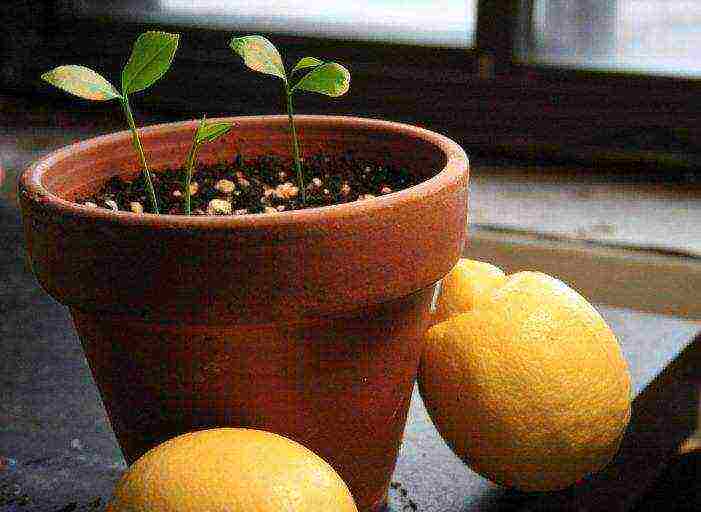
A home garden can not only delight the eye with fragrant flowers, but also bear useful fruits. For example, in a pot on a windowsill, you can grow a fragrant lemon, or even a tangerine. The citrus tree will become the healthiest plant in your home garden. The easiest way to buy an already sprouted tree at a flower shop, however, will not give as much pleasure as one grown from a stone.
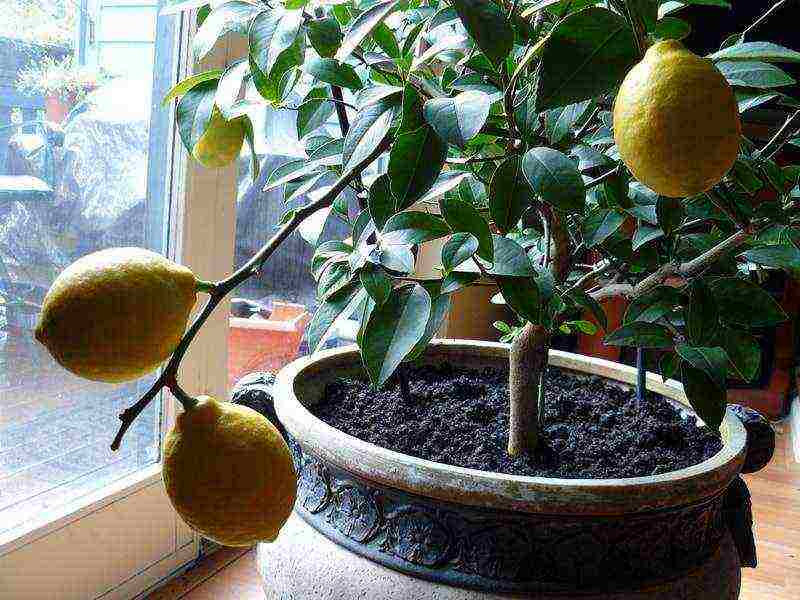
To do this, in fact, is very simple, and even a novice florist can cope with this task. It is best to use seeds of homemade lemons, for example, the Miyer variety (it is small and frost-resistant), these plants are not watered with all kinds of fertilizers to accelerate growth, and the fruits are not treated with chemicals to extend the shelf life, and the likelihood of growing a healthy tree from homemade lemon seeds is much higher. However, when there is no way to get the seeds of a home plant, lemons bought in the store are used.
Procedure
The first thing to do is to carefully separate the seeds from the fruit itself, without damaging their shells, then rinse them under water, removing the remnants of the fruit. When the seeds are ready, they must be wrapped in wet gauze. It is recommended to use gauze as a material, as it allows enough air to pass through and will not allow the bones to rot. It is advisable to change the gauze every two days. It is best to moisten several seeds at once, then the chance of germination will increase. In this form, the bones will lie from three weeks to one and a half months, depending on the rate of germination. As a result, a sprout should appear from the seed, and then it must be planted in a pot.
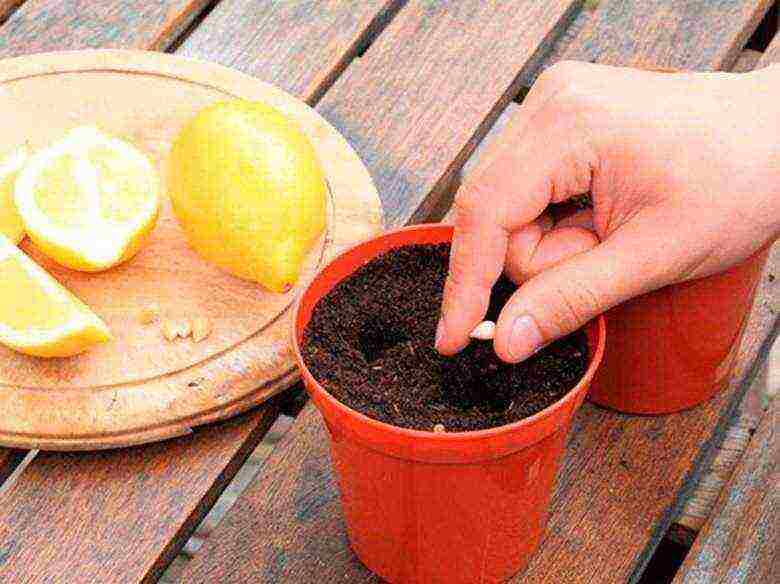
It is not necessary to choose an earthen pot as the container for the seed. In the first couples, it can be a half liter plastic cup or a mayonnaise bucket. At the bottom and sides of the future pot, you need to make several holes to drain excess moisture. The lemon tree is a rather whimsical plant, and it will not grow in ordinary land, so it is better to take care of this circumstance in advance and purchase a special soil for citrus fruits, it can be found in any flower shop. Place drainage on the bottom of the pot. Expanded clay or crushed eggshells can act as drainage.
If you have problems buying specialized soil, then you can try to grow lemon seeds from seeds in a mixture consisting of:
- four glasses of earth;
- two tablespoons of ash;
- six spoons of humus or manure;
- glasses of river sand.
Video on how to grow lemon from seeds:
Care
Lemon is a light-loving plant, so it is advisable to place it in the sunny part of the room. Experienced growers are not recommended to move the pot with the plant from place to place, but it must be turned a little once a week so that all the leaves are illuminated, and the crown does not turn out to be one-sided. You need to water the tree every two days, while sprinkling the leaves with a sprinkler.
Many citrus fertilizers can be found on the shelves in flower shops, and it is advisable to feed the plant in the first year of life to strengthen the root system. As soon as the lemon gets stronger and picks up 5-6 leaves, it's time to pinch the tops. It is best to do pinching with tweezers, but in the absence of it, you can do it gently with your fingernail. Due to the timely removal of the tops, the tree will give side branches, which contributes to the formation of a beautiful fluffy crown.
It must be remembered that the lateral shoots should also be pinched when 3-4 leaves are formed on them.

Many believe that a tree grown from a seed cannot grow strong and healthy, and will not bear fruit. In fact, this is a deep misconception. With proper care, the lemon tree will be full of delicious, aromatic fruits in just five years.
Another pleasant bonus that citrus lovers receive is freshness and a pleasant aroma in the apartment, because the leaves of the plant are able to increase the humidity in the room and exude a light, unique fragrance.
Hello!
Today I want to tell you in detail how to grow a lemon from a seed at home. Yes, not just a lemon, but a real tree with fragrant and healthy fruits. Last year I wrote about growing tangerine from seed and in the comments there was a request to tell about lemon. There are some points to consider in order to drink tea with your lemons after a few years.
Growing lemon from seed at home
Lemon is an evergreen bush with glossy, fleshy leaves. On them and on the branches of the bush there are many pores that emit essential oils and phytoncides - this is a wonderful lemon scent we all know.
A lemon grows at home as a small tree, but it can be up to three meters. It has small thorns on the branches, the leaves are dark green. Lemon has beautiful small flowers - pink-red or purple on top and white on the inside.
 Lemon flower
Lemon flower
It's just that you won't surprise anyone with a lemon tree now, but a tree with fruits is not so common. But this is a completely feasible task for everyone.
Landing
Let's start from the very beginning. You need to choose the right seeds for planting and prepare the ground. We choose a beautiful, even, ripe lemon fruit. We choose the best from it - large seeds. And we plant in a wet state - there is no need to dry, otherwise they will sprout for a long time or will not germinate at all.
Before planting, you can treat the seeds with any biostimulant for quick germination and the formation of good roots in the future. To do this, prepare a solution according to the instructions for the preparation - and soak the seeds overnight.
It is necessary to prepare containers for sowing and good soil. You can buy seedling pots at the store or use yogurt or sour cream cups for this, cut off plastic bottles. At the bottom you need to make holes and put drainage. It can be shards from pots, nut shells, pebbles, a layer of vermiculite up to 1.5 cm.
Plant a lot of lemon seeds at once - a couple of dozen at once. Firstly, not everyone will grow, and secondly, you will have the opportunity to choose the best ones for further cultivation, and finally, not everyone can tolerate the vaccination well.
Maybe it will seem to someone that the information about the holes in the cups, about the need for drainage is known to everyone and there is no need to write about it in such detail. But I remember myself as a novice gardener and I did not always know all the intricacies of planting and care.And the plants died.
Now you need to prepare loose, fertile soil. Planting lemons in commercial citrus soil or making your own is no problem. We mix humus, leafy earth in equal amounts and add peat and sand for ease. We moisten the earth and lay out the bones in pots. We plant the seeds to a depth of about 2 cm.
The temperature for germination of lemon pits must be at least 18 ° C. To create the best conditions for lemons to germinate and develop, cover them with cut-off plastic bottles. Or just cover the seed cups with foil and put them in a warm place. This will create the conditions for a greenhouse for lemons.
 Lemons under plastic bottles - mini greenhouse
Lemons under plastic bottles - mini greenhouse
You do not need to fill in the seeds after sowing - they can suffocate and mold. It is better not to water at all, but simply spray the ground with a spray bottle. Water only when the ground begins to crack. And after the emergence of lemon shoots, it is also better to observe the low watering regime so that the roots do not rot.
Growing lemon from seed at home
Sprouts appear in an apartment in different ways. It can take from two weeks to a month. Until 4 leaves appear, young seedlings are kept in mini-greenhouses. We gradually accustom the seedlings to room air - we spray them more often. Then we rearrange the pot in a bright place, but without direct sunlight, otherwise the young sprout will die.
Do not forget about watering, in the sense that do not get carried away
Water the seedlings only after the soil is dry.
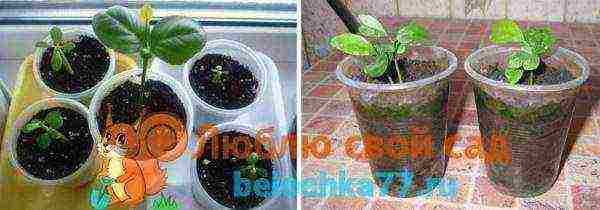 The first shoots and small seedlings of lemon
The first shoots and small seedlings of lemon
Helpful hints:
- Use water at room temperature. Rain and melt water is good for irrigation - just not cold.
- A small lemon is not fed in the first months. In spring and summer, you need to water with biofertilizer. But always remember that underfeeding is better than overfeeding.
- Don't forget that the lemon tree is a moody and demanding plant when grown indoors. It likes constant temperature or humidity. Abrupt changes in climate and care will immediately reflect a deterioration in the health of the lemon.
- Hot, dry climate, exposure to direct sunlight, drafts and cooling of the air, wind - these factors can lead to the loss of all leaves and death of the plant.
- By autumn, watering is completely reduced, only after the earth dries up is the land lump moistened. Be sure to make sure that the water does not stagnate, and the excess flows freely. They are fed in the fall once a month.
- Already in the first year of growth, the seedling begins to form its crown. Remove all deformed, inward growing weak branches.
Growing lemon at home in a pot
When there are 2-3 true leaves on the seedlings, the strongest are chosen and transplanted into pots. For lemon, it is best to grow only in clay pots. The diameter and depth increase as the tree grows. A few hours before transplanting, the pot must be soaked in water. Be sure to put a drainage layer on the bottom. You can cover the hole with a crock, with the convex side facing up. Pour small shards, pebbles, coarse sand, coal, expanded clay on top.
We fill in the soil the same as was prepared when planting lemon seeds. After transplanting, cover the seedlings with a jar or half a bottle again. We remove it only after the seedling has completely taken root. At the same time, new leaves will begin to grow.
How to choose the best seedlings for transplanting... Here are the main things to look out for:
- We look at the density of the crown. See the distance between the buds on the seedling - take with the smallest ones.
- The presence of needles. Less is better.
- The quality of the leaves. There are many of them, hold on tightly, do not fall off from the touch.
- All weak, thin shoots with bad leaves are immediately rejected.
Lemon tree - care rules and growing problems
Growing lemons at home requires special care. If you follow all the rules, you can get flowering and fruiting plants.
- For lemon, additional lighting is needed - especially in early spring and autumn.
- A humid climate must be created in the room. To do this, spray the plant more often. Give him a shower, wash the leaves - lemons are tropical inhabitants and love high humidity.
- Frequent transplants are important for a young lemon. We prepare the earth as for the first landing. Plants are necessarily transplanted with a clod of earth. They take a new pot 5-7 cm more. Young ones - once a year, an adult plant can be transplanted every 2-3 years. The best time in summer is in June, and in winter we transplant in February.
- In the period from February to September, lemon grows more actively - therefore, you need to feed the bushes with biofertilizers at this time, alternating with mineral fertilizers. We feed only with liquid fertilizers. Let's not forget the rule: less is better than more.
- We form plants correctly. To make the tree more luxuriant and actively grow lateral shoots - pinch the top of the head. Better to do this in the first year of growth.
- For proper crown formation, the pot should be turned a quarter every week. In the future, a well-formed trunk will affect the quality of the fruit.
- If the lemon at home began to bloom in the first year, then you need to cut off all the flowers - do not regret it. Lemon spend all its energy on flowers and then wither away. Lemon can be allowed to bloom when the plant has at least 15 leaves per flower!
Will seed-grown lemon bear fruit
Full-fledged fruit plants grow from the seeds, but they begin to bear fruit late. Seedlings grown from seeds are more adaptable to home conditions. They are more hardy than cuttings.
In order for the lemon to start bearing its first fruits early, you can graft it with other citrus fruits. For example:
tangerine
, grapefruit. The optimal time for this operation is early summer or spring.
Another important factor is the formation of the crown. As I already wrote, in the first year they pinch the top of the head - more precisely, when the seedling grows to 20 cm.Then branches of the second order begin to grow, they are pinched when they grow 18 cm.Further, the process is repeated until the branches of the 4th order appear - the first flowers and fruits appear on them ...
 Fruit-bearing lemon at home
Fruit-bearing lemon at home
And yet, before flowering, the lemon needs to rest. To do this, in the winter, put it in a cool place for several months. And in the spring, put it in a warm, bright place.
Types of indoor lemon
Many varieties can be grown at home - these are Pavlovsky, Maikop, Eureka, Genoa, Meyer, Novogruzinsky. The most productive is Maykop. Genoa and Eureka varieties are not tall and can grow even on a warm windowsill.
Lemon variety Pavlovsky
 Pavlovsky lemon
Pavlovsky lemon
This is an old variety of folk selection. Bred in the village of Pavlovo more than 100 years ago. The variety is very unpretentious, well adapted to home conditions - dry air and insufficient lighting.
Pavlovsky lemon
grows up to 2 meters. The crown is round. It can give from 20 to 40 fruits per year. Begins to bear fruit for 4 years.
Meyer lemon variety
 Meyer lemon variety
Meyer lemon variety
It appeared in Russia in 1929. It became widespread in Europe, as it gave rich harvests in the open field. It is considered a natural hybrid of lemon and orange.
Lemon Chinese
 Lemon Chinese
Lemon Chinese
This is a short tree - usually about a meter. Differs in high productivity. Begins to bear fruit early - for 2-3 years. Fruits are early ripening, blooms on old and young shoots, blooms early.
Shades poorly - must be grown on the south and southwest windows. It tolerates heat well, but during the dormant period, the leaves need coolness and moisture.
Lemon variety Jubilee
 Lemon variety Jubilee
Lemon variety Jubilee
Unpretentious, productive, decorative variety. Grows up to 1.5 meters. It blooms very profusely - it looks like a white ball from the abundance of flowers. Fruits weighing 500 grams with a thick, yellow skin. Begins to bear fruit in the 2nd year of life.Shade-tolerant, grows quickly and adapts well to different conditions. The fruits are tied in any conditions.
Genoa lemon variety
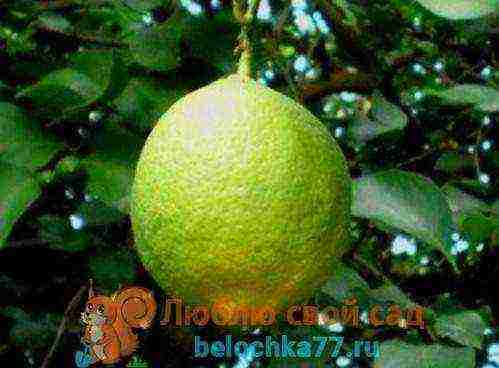 Genoa lemon variety
Genoa lemon variety
This variety can be from 1 to 3 meters long, without thorns. Begins to bear fruit at 4-5 years. Usually about 50 fruits are harvested per year. On an adult tree, up to 100 pieces. It blooms several times a year, genoa lemons are medium-sized up to 100-120 gr. Differs in high palatability of fruits.
Lemon variety Maikop
 Lemon variety Maikop
Lemon variety Maikop
The variety is common for growing at home, as it is very unpretentious and fruitful. It tolerates cold well. The mass of lemons is 120-160 gr., 200-300 fruits are harvested per year. Trees at the age of 30 give 700 fruits a year. Branches without thorns.
Lemon variety Novogruzinsky
 Lemon variety Novogruziskiy
Lemon variety Novogruziskiy
Tall tree up to 3 meters. Begins to bear fruit for 4-5 years. The fruits are very aromatic, with a thin crust, without seeds. With good care, it produces up to 200 fruits per year.
How to plant lemon at home
The best way is the graft vaccination. I suggest watching a video on how to carry out this operation.
Indoor lemon pests and diseases
The most common pests of lemons at home are scale insects, aphids, spider mites, and scale insects. All of them suck sap from plants, leading to curvature of shoots, drying of leaves.
With all pests, there are general rules for the fight to save the lemon:
- Brush off insects from twigs with a soft toothbrush. It can be removed from the leaves with a cotton swab. We wet the instruments in a soapy solution of anabasine sulfate.
- After a day, we wash off the solution from the plant. After a week, we repeat the treatment.
- In case of severe pest damage, we process the bushes with infusions of onions, garlic, celandine, tobacco. Or we use drugs Aktellik, Fitoverm (biological product). Use chemicals very carefully at home - these are strong poisons.
 Lemon diseases
Lemon diseases
The main diseases of all citrus fruits at home are sooty fungus and gommosis. From the fungus, the leaves become covered with a gray coating, in which their nutrition is disturbed. And with homoz, gum appears at the sites of damage to the bark - the branches and leaves gradually dry out.
Actions for diseases:
- We clean the bark or the place of the disease - we process it with vitriol (copper).
- We cover it with RanNet (or garden varnish).
- Wipe the leaves with the fungus with a wet cloth.
- We feed with fertilizers to maintain the strength of the plant to fight the disease.
How and in what quantities to use drugs for plant treatment or pest control can always be read on the packaging of each drug. You will find a large number of them in any specialty store.
Growing lemon in a greenhouse
As stated earlier, the lemon tree loves:
- Strong but diffused light
- Good root breathing
- Constant freezing temperatures all year round
All these conditions can be observed in the best way in conditions: greenhouses, loggias or balconies with glazing, in a greenhouse or conservatory.
Growing lemons and other citrus fruits in a greenhouse has its own characteristics. You can plant lemons directly in the ground or in pots. For cultivation in soil, the greenhouse must be heated.
Let's take a closer look at the requirements for the greenhouse in which the lemon will grow:
- A prerequisite is that even in severe frosts, the temperature should not fall below + 6 ° С, but preferably + 10 ° С.
- A lot of ambient light is needed. In the autumn-winter period, you need to use additional lighting, and in the spring and summer, on the contrary, shade from direct sunlight.
- Remember that lemons do not tolerate stagnant air, with high humidity - you need to ventilate the greenhouse. But don't create drafts!
In an apartment, the most suitable place for planting and growing lemon is a glazed and insulated balcony or loggia.
Otherwise, the cultivation and care of plants is completely the same as described in the article.
 Lemon in the greenhouse
Lemon in the greenhouse
I will repeat the main points that are important for obtaining full-fledged seedlings:
- Choosing beautiful fruits
- We sow freshly harvested wet seeds - do not dry!
- Water gently as the soil dries
- We cover the pots with foil or bottles - we create a mini-greenhouse.
- When applying fertilizers, remember the rule: it is better to underfeed than overfeed.
- We form and transplant young lemons on time
Plant and grow lemons with pleasure!
This is where I end. How to grow a lemon from a seed is now no secret for you. If you have any questions or comments - write in the comments.
Best regards, Sophia Guseva.
Other interesting articles:
- Growing a tangerine from a bone
- Marigolds - planting and care. Photo of flowers
- How to grow gladioli outdoors
- Types of roses with photos and descriptions
- How to plant mango from seed
In natural conditions, lemon trees grow in the tropical zone and reach a height of two to six meters. It is a perennial evergreen plant. When growing lemon trees in standard city houses and apartments, these plants reach a lower height, but if the plant is not formed, then it can be very stretched. Growing Lemon Growing a lemon is a fun and exciting process that requires certain knowledge and skills, but which are more than compensated for by positive emotions when your homemade citrus begins to bloom and bear fruit.
How you can grow yourself at home Lemon from a stone A lemon from a stone, or also called "Wild Lemon" - is a lemon grown from a stone and which is not a cultivated varietal plant. As a rule, such citrus trees do not bear fruit at home. If you want to get fruits from them, then you can use them on the stock, that is, graft a varietal citrus plant to them. seed lemon and how will it differ from a citrus cultivar from a cuttings?
You can plant a lemon tree at home using cuttings or seeds. It should be borne in mind that varietal plants retain their properties only during vegetative propagation, that is, propagation by cuttings. From the seeds, you will get a citrus plant that will not bear fruit at home.
Special home varieties of citrus fruits, for example Pavlovsky Lemon Lemon is an evergreen plant from the genus Citrus, and the fruit of this plant also bears this name.
Mandarin is an evergreen citrus plant, as well as its eponymous fruit.
tangerines are able to bear fruit throughout the year and at the same time have small crowns, and their pleasant citrus aroma during flowering and aesthetically attractive appearance will add comfort to your room.
Pitted Lemon Pitted Lemon or also called "Wild Lemon" is a pitted lemon that is not a cultivated varietal plant. As a rule, such citrus trees do not bear fruit at home. If you want to get fruits from them, then you can use them on the stock, that is, graft a varietal citrus plant to them. Pitted lemon
To to grow a lemon from a stone A lemon from a stone or also called "Wild" is a lemon grown from a stone and which is not a cultivated varietal plant. As a rule, such citrus trees do not bear fruit at home. If you want to get fruits from them, then you can use them on the stock, that is, graft a varietal citrus plant to them.
Lemon from the seed you need to find the seeds. To obtain seeds, it is enough to buy ripe, strong fruits in any store that have a uniform color without signs of spoilage or rot. Most commercially available lemons contain seeds inside that can be successfully used to plant a plant. The disadvantage of growing a lemon tree from seeds can be considered a long period of plant growth.Plants obtained from cuttings of varietal plants develop significantly faster and are guaranteed to produce fruit with proper care.
Preparing lemon seeds for planting
For planting lemon tree seed seeds of regular shape are suitable, the integrity of which is not damaged. For a greater likelihood of their successful germination, it is most advisable to take seeds from several different lemons. Also, to increase the germination of seeds, soak them for several hours in a root solution. The next step is to plant in pots or boxes. We plant often, it is better to remove excess shoots later than not to wait for them at all. For planting, you can buy ready-made soil for citrus fruits, or you can mix peat and flower soil in equal proportions. At the bottom of the planting container, be sure to put a good layer of drainage. In this capacity, expanded clay balls or ordinary foam are usually used.
Planting lemon seeds in the ground
Lemon seeds should not be buried too deep in the soil. It is enough to immerse them to a depth of 1 cm to 0.5 cm. In no case should it be poured with soil, but it is imperative to keep it moderately moist. The temperature most conducive to seed germination is 18-22 degrees. With proper observance of these simple conditions, a couple of weeks after planting, the seeds will give the first shoots. Among these seedlings, it will be necessary to select only strong, strong and healthy plants, the rest will have to be removed. It is recommended to cover the seedlings with a glass jar to maintain the microclimate and humidity required for the plant. Once a day, you need to ventilate the plants, removing the jar for a few minutes. Containers with seedlings should be in a bright, warm place without direct sunlight.
Lemon shoots
It is possible to transplant seedlings when growing a lemon from a seed into separate small pots only after the first pair of real adult leaves appear on the seedlings. Drainage in new pots is required. It is advisable not to damage the roots during transplantation. To do this, it is best to transplant the plant along with the old peat lump, without trying to separate it from the roots. When a small tree grows up to 15 centimeters, it will need to be transplanted back into a pot of a larger size and diameter.
Lemon tree from cuttings
When planting a lemon tree, a cutting about 8-10 cm long is taken from the cutting, on which a couple of leaves and several live buds are left. Before placing the cuttings in the ground, it is advisable to treat its base with a root formation stimulant, for example Kornevin, and then plant it in the soil to a depth of 3-4 centimeters and cover with a jar or bag. Until the cutting has roots, it will need to be sprayed daily with water and the soil in which it is rooting is well moistened. Rooting occurs in about a month and a half after planting. It should be borne in mind that only some cuttings take root - this is to some extent a matter of luck. The plant can then be transplanted into a permanent pot.
When watering a lemon tree, you need to evenly moisten the earthen ball in the pot. Insufficient and uneven moisture can lead to drying out of the roots and their death. When the tree is already old enough and strong enough, it will need a lot of sunlight. But lemons do not tolerate direct sunlight, it is better to choose a bright place for it, which receives diffused light. Lemon trees do not like constant movement from place to place. Each spring, it must be transplanted into a larger container. You can stop at a ten-liter container, regularly changing only the top layer of the soil and actively fertilizing the plant.
Proper care will ensure flowering and fruiting of varietal lemon
During the heating season or dry summer, it is necessary to spray the plant daily to maintain the moisture it needs.To form a beautiful crown and release side branches, the top of the tree must be cut from time to time. Proper care and conditions must be provided for lemons to form on an adult tree. If there are too many fruits on the tree, it is better to remove some of them, as they will over-deplete the plant.
Summary
Growing Lemon Growing a lemon is a fun and exciting process that requires certain knowledge and skills, but which are more than compensated for by positive emotions when your homemade citrus begins to bloom and bear fruit.
Growing a lemon from a seed at home is an interesting and exciting process. It is good for those who want to watch a living citrus plant emerge from a small seed. It should be borne in mind that citrus grown from a seed will not have the properties of varietal plants - a compact crown and the possibility of fruiting at home.
To have a beautiful and fruiting citrus plant, it is worth buying a varietal type of homemade lemon. You can independently get such a plant from cuttings, but the process requires skills and a certain amount of luck.
Whichever way your plant is obtained, when grown in a pot, in order to develop well, it needs the correct seasonal feeding of domestic citrus plants.
(Visited 126 times, 8 visits today)


